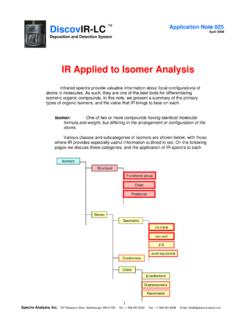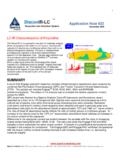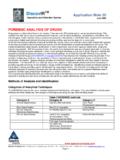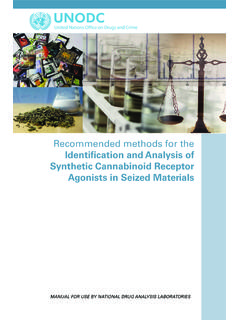Transcription of Polymer Additives Analysis
1 Polymer Additives Analysis Additives are embedded in small quantities in most commercial polymers, where they perform a variety of essential Polymer performance functions. Presented here is a novel Polymer sample Analysis method for rapid identification of Additives responsible for the chemical protection of the base Polymer . Additives extracted from a Polymer sample can be separated by HPLC protocols, and the individual components identified by spectral Analysis . The above figure is the HPLC-IR chromatogram of such a sample. Spectra acquired during elution are shown at left. The IR spectra provide unequivocal identification of components The combination of HPLC and DiscovIR-LC provides a Single step method for identification of Polymer Additives in extracts. Quantitation can be obtained from the chromatogram, using standardized methods and internal standards DiscovIR-LC Deposition and Detection System TM Application Note 019 February 2008 2 Spectra Analysis , Inc.
2 257 Simarano Drive, Marlborough, MA 01752 Tel: + Fax: + Email: Introduction A host of additive chemicals are used to provide a variety of characteristics in polymers. Some of the most common functions include: Flexibilizers Colorants/Pigments Biocides Antistats Slip agents Fillers (modify mechanical properties) Stabilizers (antioxidants, UV stabilizers) Flame retardants The Polymer stabilizers prevent degradation of the Polymer arising from exposure to heat, light, and oxidants 1) during base Polymer manufacture, 2) during resin processing in operations such as molding, extrusion, and forming, and 3) to prevent degradation of fabricated products. Typically specific Additives are designed for each phase of the product life cycle, and there are hundreds of such Additives commercially available. Analysts include Research and development personnel, product engineering, and quality control personnel.
3 Technologists in end-use industries also perform these analyses. Objects of such analyses include: Product composition control Health/safety (food packaging) Environmental control of leachates (especially those with oestrogenic properties) Monitor levels of stabilizers (UV, antioxidants) and their degradation byproducts to ensure product stability. The stabilizers can be lost by leaching or additive decomposition1. Therefore, the identification and quantification of Additives present, and their possible breakdown products, are invaluable for product quality control. Product deformulation Quantitation for QC Monitor additive stability during product processing and end product life End product failure Analysis Typically 4 steps are employed in the analytical methods: 1. Separate Additives from solid Polymer samples, and also from solids such as fillers.
4 2. Fractionate extract to obtain separate components. Typically by HPLC or SEC. 3. Identify/quantify the individual components ( Additives , degradation products). Methods include MS, FTIR, NMR. ASTM D 6042-96 is a typical extraction protocol for the determination of Additives in polypropylene homopolymer formulations., and the example shown here follows that method. 3 Spectra Analysis , Inc. 257 Simarano Drive, Marlborough, MA 01752 Tel: + Fax: + Email: Experimental Samples of the individual components2 were injected on-column and collected with the DiscovIR-LC. Elution times were determined. Following this, a sample of these Additives plus an internal standard (Tinuvin P) were prepared in a solution of acetone, and similarly run. HPLC conditions: Columns: guard+ Eclipse C18 50mm x 46mm 5um Mobile phase: Grad. 75-100% AcN (5min)-100%AcN(5min) in Water, 1ml/min DiscovIR conditions DiscovIR(S7H6) conditions: Nebulizer , Carrier gas 400cc, Disk Speed 3mm/min, Disk Temp.
5 -110 C, Pressure Chamber/Cyclone torr Condenser (single) temp. 10 C, Cyclone temperature: 200 C This figure shows the elution times of individual components and the mixed solutes sample. 4 Spectra Analysis , Inc. 257 Simarano Drive, Marlborough, MA 01752 Tel: + Fax: + Email: Displayed above are the spectra obtained from the four chromatography elution peaks. Robust and distinct spectra were obtained for each solute permitting ready identification or components. Note the sharp hydroxyl band (3640 cm-1) in the two Irganox compounds. This band is a signature identification of hindered phenol antioxidants. It is helpful to create a user library of such spectra. When analyzing Polymer samples of unknown composition, a good library match enables ready identification of components. One can also expect to encounter additive degradation products in a Polymer sample extract, and spectral identification/quantitation of all extract components can aid understanding of the protection afforded to the base Polymer .
6 1 F. Bourges, G. Bureau, J. Dumonceau, B. Pascat, Effects of electron beam irradiation on antioxidants in commercial polyolefins: Determination and quantification of products formed, Packaging Technology and Science Vol 5, Issue 4 , pp 205 - 209 2 Spectra Analysis gratefully acknowledges CIBA for providing sample materials used in this project. Irganox and Cyasorb are trademarks of Ciba corporation.




